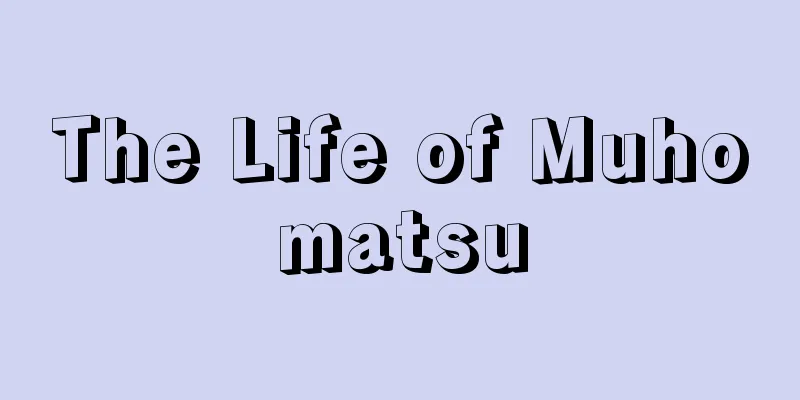The Life of Muhomatsu

|
This is a novel by Iwashita Shunsaku (1906-1980), a writer born in Kokura, Fukuoka Prefecture. He first submitted his work, titled The Legend of Tomishima Matsugoro, to Kaizo magazine in 1938 (Showa 13), where it was selected as an honorable mention. In 1941, it was published in Kyushu Bungaku, and was shortlisted for the Naoki Prize. It is a medium-length story depicting the lonely life of Matsugoro, an outlaw rickshaw driver living in Kokura, Kitakyushu, and his secret love for Yoshiko, the widow of Captain Yoshioka. The protagonist is a character who combines the virtue of patience with the consciousness of an outlaw. It has been featured repeatedly in plays, films, television, and other media, and has become a popular idol. In particular, the 1943 film adapted by Itami Mansaku, directed by Inagaki Hiroshi, and starring Bando Tsumasaburo is famous, and the title of this film has become established. [Hideki Ozaki] movieA Japanese film. Based on Iwashita Shunsaku's "Tomishima Matsugoro Den," it was first made into a film in 1943 (Showa 18) by Daiei, with a screenplay by Itami Mansaku and directed by Inagaki Hiroshi. After the Russo-Japanese War, Matsugoro (Bando Tsumasaburo), a generous rickshaw driver working in Kokura, Kitakyushu, rescues an injured boy (played by Nagato Hiroyuki (1934-2011) as a child actor), and after the death of the boy's father, an army captain, he devotes his love and affection to the boy and his widow (Sono Keiko (1913-1945)). With a brilliant performance by Bando Tsumasaburo and outstanding visual expression by the brilliant duo of cameraman Miyagawa Kazuo (1908-1999) and Inagaki Hiroshi, this became one of the greatest masterpieces rich in lyricism, but during the war, the scene depicting Matsugoro's love for the widow was cut by censorship from the Ministry of the Interior, and after the war, the lantern procession and violent scenes were cut by censorship from GHQ. Inagaki attempted to fully adapt Itami's script, and in 1958 (Showa 33), he directed it for Toho in color and CinemaScope, starring Mifune Toshiro, which won the Golden Lion at the Venice International Film Festival. Subsequent versions of "The Life of Muhomatsu" include a 1963 Toei production written by Ito Daisuke, starring Mikuni Rentaro (1923-2013), and directed by Murayama Shinji (1922-2021), and a 1965 Daiei production written by Itami Mansaku, starring Katsu Shintaro, and directed by Misumi Kenji (1921-1975). [Mika Tomita] "Itami Mansaku, Complete Works 3" (1961, Chikuma Shobo) edited by Shiga Naoya" ▽ "Bando Tsumasaburo" edited by Irie Shigeru (1962, Bantsuma Gafu Kankokai)" ▽ "Japanese Scenario Series 1" edited by the Scenario Writers Association (1973, Maruyon Production Scenario Bunko)" ▽ "The Young Days of Japanese Film" by Inagaki Hiroshi (1978, Mainichi Shimbun)" ▽ "Photographs of Bantsuma Films" edited by Misono Kyohei (1979, Activity Materials Research Association)" ▽ "Beards and Topknots - A Living History of Film" by Inagaki Hiroshi (1981, Chuokoron-Shinsha) ▽ "The World of Miyagawa Kazuo - Carving Images" by Watanabe Hiroshi (1984, Herald Enterprises)" ▽ "Inagaki Hiroshi in My Heart" by Takase Masahiro (2000, Wise Publishing) "The World of Cinematographer Kazuo Miyagawa - A Film History of Light and Shadow" (2000, Kinema Junposha) ▽ "The Legend of Matsugoro Tomishima" (Chuko Bunko) [References] | | | | |Source: Shogakukan Encyclopedia Nipponica About Encyclopedia Nipponica Information | Legend |
|
福岡県小倉(こくら)生まれの作家、岩下俊作(いわしたしゅんさく)(1906―1980)の小説。初め『富島松五郎(とみしままつごろう)伝』と題して1938年(昭和13)『改造』の懸賞小説に応募し佳作入選、1941年『九州文学』に発表、直木賞の候補となった。北九州小倉に住む無法者の人力車夫松五郎の孤独な生涯と、吉岡大尉の未亡人よし子に寄せる彼の秘めた愛を描いた中編で、忍従の美徳とアウトローの意識が一体化した人物を主人公にしている。演劇、映画、テレビなどでも再三取り上げられ、大衆のアイドルとなった。とくに伊丹万作(いたみまんさく)脚色・稲垣浩(いながきひろし)監督・阪東妻三郎(ばんどうつまさぶろう)主演の映画(1943)は有名で、その映画タイトルが定着した。 [尾崎秀樹] 映画日本映画。岩下俊作の『富島松五郎伝』を原作とし、初映画化は1943年(昭和18)、伊丹万作脚本、稲垣浩監督の大映作品。日露戦争後の北九州小倉で働く豪放な車夫・松五郎(阪東妻三郎)が、怪我(けが)をした少年(子役時代の長門裕之(ながとひろゆき)、1934―2011)を助け、その父・陸軍大尉亡き後、未亡人(園井恵子(そのいけいこ)、1913―1945)と少年に献身的愛情を捧げる。阪東妻三郎の名演、カメラマン宮川一夫(みやがわかずお)(1908―1999)と稲垣浩の名コンビによる卓越した映像表現で、叙情性豊かな屈指の名作となったが、戦時中に内務省検閲で松五郎の未亡人への思慕を描いた場面がカットされ、戦後はGHQの検閲で提灯(ちょうちん)行列や暴力的場面がカットされた。稲垣は伊丹脚本の完全映画化を試み、1958年(昭和33)に東宝で、三船敏郎主演、カラー、シネマスコープで監督し、ベネチア国際映画祭金獅子賞を受賞。その後も『無法松の一生』は、1963年の伊藤大輔脚本、三國連太郎(みくにれんたろう)(1923―2013)主演、村山新治(むらやましんじ)(1922―2021)監督の東映作品、1965年の伊丹万作脚本、勝新太郎主演、三隅研次(みすみけんじ)(1921―1975)監督の大映作品などがある。 [冨田美香] 『伊丹万作著、志賀直哉監修『伊丹万作全集3』(1961・筑摩書房)』▽『入江しげる編『阪東妻三郎』(1962・阪妻画譜刊行会)』▽『シナリオ作家協会編『日本シナリオ大系1』(1973・マルヨンプロダクションシナリオ文庫)』▽『稲垣浩著『日本映画の若き日々』(1978・毎日新聞社)』▽『御園京平編『写真阪妻映画』(1979・活動資料研究会)』▽『稲垣浩著『ひげとちょんまげ――生きている映画史』(1981・中央公論社)』▽『渡辺浩著『宮川一夫の世界――映像を彫る』(1984・ヘラルド・エンタープライズ)』▽『高瀬昌弘著『我が心の稲垣浩』(2000・ワイズ出版)』▽『『撮影監督・宮川一夫の世界――光と影の映画史』(2000・キネマ旬報社)』▽『『富島松五郎伝』(中公文庫)』 [参照項目] | | | | |出典 小学館 日本大百科全書(ニッポニカ)日本大百科全書(ニッポニカ)について 情報 | 凡例 |
>>: Unprotected City - Unprotected City
Recommend
Cozens, JR
…Father and son, British watercolorists. The fath...
Glauber, Roy J.
Born: September 1, 1925, New York, New York [Died]...
Han
This dynasty (202 BC - 220 AD) unified and ruled ...
Forment, D. (English spelling) FormentD
…The Gothic style was introduced in the 14th cent...
Lookout post - Toomibansho
〘Noun〙① A place where lookouts kept watch. ※Nitta ...
Evil deeds - Akugyo
〘noun〙 Bad deeds. Indecent behavior. Immorality. ※...
International Bowling Board
…The number of enthusiasts has been increasing re...
Mr. Takubatsu
A tribe of the Xianbei, a nomadic people of North...
Solubility product
This refers to the concentration product of catio...
Eloa (Economy) - Eloa
...A general term for "Government and Relief...
Ulrich, A.
…On the other hand, the novels that increased in ...
Telephos (English spelling)
In Greek legend, King of Mysia in Asia Minor. Son ...
Geopelia
… Most species live mainly in trees. However, the...
Maritime Law
A general term for laws related to navigation. In...
Gülick, JT
…However, it was M. Wagner (1868) who proposed th...





![Tsukude [village] - Tsukude](/upload/images/67cc3b75a9d24.webp)



